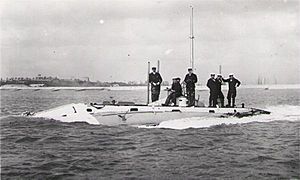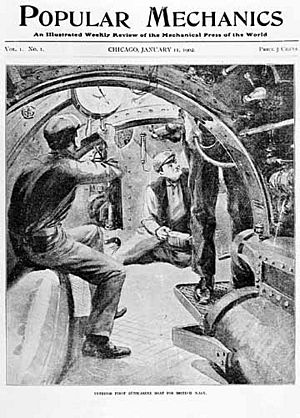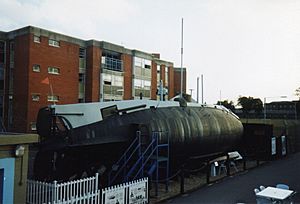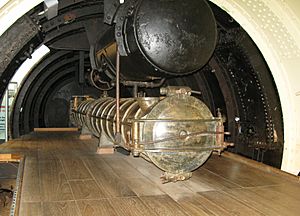HMS Holland 1 facts for kids

Holland 1 under way
|
|
Quick facts for kids History |
|
|---|---|
| Name | Holland 1 |
| Ordered | 1900 |
| Builder |
|
| Laid down | 1900 |
| Launched | 1901 Yacht Shed No 1 |
| Commissioned | 1901 |
| Decommissioned | 5 November 1913 |
| Fate | Lost while under tow, subsequently raised |
| Status | On display at Royal Navy Submarine Museum, Gosport |
| General characteristics | |
| Type | Submarine |
| Displacement | 105 long tons (107 t) submerged |
| Length | 63 ft 10 in (19.46 m) |
| Beam | 11 ft 9 in (3.58 m) |
| Propulsion |
|
| Speed | 7 knots (8.1 mph; 13 km/h) submerged |
| Range | 20 nmi (37 km) at 7 kn (8.1 mph; 13 km/h) submerged |
| Test depth | 100 ft (30 m) |
| Complement | 9 (Lieutenant, Sub-Lieutenant, Coxswain, Torpedo Instructor, Chief Engineering Artificer, Leading Stoker, Stoker, Leading Seaman and Able Seaman) |
| Armament |
|
The Holland 1 (also known as HM submarine Torpedo Boat No 1) was the very first submarine used by the Royal Navy. It was the first of five similar submarines. In 1913, after it was no longer in service, it sank while being pulled by another ship to be taken apart.
However, in 1982, the submarine was found and brought back up from the sea. Today, you can see it on display at the Royal Navy Submarine Museum in Gosport. Amazingly, when its old batteries were found, they still worked after being cleaned and recharged!
Contents
Building the Holland 1
The Royal Navy ordered the Holland 1 in 1901. It was built by John Philip Holland at Barrow-in-Furness. Work on the submarine started on February 4, 1901.
To keep the submarine's construction a secret, it was put together in a building called the "Yacht Shed." Parts made in other areas of the shipyard were secretly marked for "pontoon no 1."
The Holland 1 was officially launched on October 2, 1901. It made its first dive in a closed area on March 20, 1902. Its sea trials, which are tests in the open water, began in April 1902.
Early Days and Incidents
In September 1902, the Holland 1 arrived in Portsmouth. It joined another completed Holland submarine and their support ship, HMS Hazard. Together, they formed the "First Submarine Flotilla." Captain Reginald Bacon was in charge of this group.
On March 3, 1903, there was an explosion on board Holland 1. Four people were hurt in this accident.
In October 1904, Holland 1 and other submarines sailed from Portsmouth. They were going to confront a Russian fleet. This Russian fleet had accidentally sunk some British fishing boats in the North Sea. This event is known as the Dogger Bank incident. Luckily, the submarines were called back before any fighting happened.
End of Service
The Holland 1 was taken out of service and sold in 1913. It was sold to a company called Thos. W. Ward for £410. By this time, the submarine was considered very old-fashioned. Because of this, it was sold with almost everything still inside. The only rule for the buyer was that the torpedo tube had to be made unusable.
How the Holland 1 Sank
While the Holland 1 was being pulled by another ship to the scrapyard, it ran into very bad weather. It sank about one and a half miles off the Eddystone Lighthouse.
No one was on board the submarine when it sank. The crew of the tugboat that was pulling it were ready. They had seen the submarine sinking earlier in the trip. This allowed them to quickly release the tow rope. This prevented any damage to their own tugboat.
Finding and Saving the Submarine
A historian from Plymouth, Michael Pearn, found the wreck of the Holland 1 in 1981. The submarine was brought up from the sea in November 1982.
Starting in 1983, the submarine was treated with special chemicals to stop it from rusting. It was then put on display at the Royal Navy Submarine Museum. Work to restore the submarine continued until September 1988. A talking figure was even added to help visitors learn about the submarine.
However, by 1993, it became clear that the anti-rust treatment wasn't working well enough. So, a special fibreglass tank was built around the submarine. From 1995, it was soaked in a solution of sodium carbonate. After four years, the harmful rust-causing chemicals were removed. This allowed the submarine to be displayed again after more restoration work.
A Historic Submarine
The Holland 1 is listed as part of the National Historic Fleet. In 2001, on its 100th birthday, a new special building was opened for it. This building has a controlled climate to protect the submarine. Countess Mountbatten opened the building.
In the same year, the Royal Mail put a picture of the submarine on a 65 pence stamp. In 2011, the submarine received an Engineering Heritage Award. This award was given by the Institution of Mechanical Engineers.
The original set of batteries from the submarine were found with the wreck. They were sent for testing by the company that first made them. After being cleaned, the lead batteries were recharged. They were found to be in good working order! Some of these original batteries are still kept by the company today.

See also
- Holland I
- Fenian Ram
- Royal Navy Submarine Service



